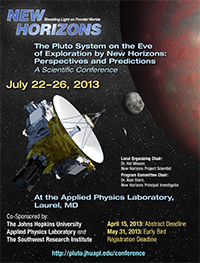
Laurel, Maryland
Hosted by
The Johns Hopkins University Applied Physics Laboratory and The Southwest Research Institute
Follow updates on Twitter via #plutosci
--------------------------------------------------------------------------------
In 2015, NASA’s New Horizons mission will conduct the first-ever reconnaissance of the Pluto system.
Pluto — a dwarf planet never before explored by spacecraft, along with its complex system of moons—has been the subject of scientific study and speculation since Clyde Tombaugh discovered it in 1930, orbiting the Sun far beyond Neptune.
By the 1990s, it became clear that Pluto possessed multiple exotic ices on its surface, a complex atmosphere and seasonal cycles, and a large moon suggesting a giant impact origin for the pair. Also in the 1990s it became clear that Pluto was no misfit among the planets, as had long been thought; instead, it was revealed to be the largest and brightest body in the Kuiper Belt—a newly discovered “third zone” of our planetary system. More recently, observations have revealed that Pluto has an unexpectedly rich system of satellites and a surface that changes over time. It has even been speculated that Pluto may possess an internal ocean. For these and other reasons, the 2003 Planetary Decadal Survey ranked a Pluto Kuiper Belt mission as the highest priority mission for NASA’s newly created New Frontiers program.
New Horizons is now 70% of the way along its journey to the Pluto system. It carries a sophisticated package with eight scientific instruments comprised of imagers, UV and IR spectrographs, plasma analyzers, a dust counter, and radio science. This payload was designed to reconnoiter the surfaces, atmospheres, interiors, and space environments of Pluto and its rich system of satellites, shedding light on the abundant new planetary class called ice dwarfs.
In preparation for the flyby of the Pluto system culminating in July 2015, the New Horizons project team will hold a scientific conference at The Johns Hopkins University Applied Physics Laboratory in Laurel, Maryland on 22-26 July 2013.
Holding this conference two years before the encounter will allow the New Horizons mission science team and interested members of the planetary science community to:
- Integrate the broad range of existing data sets and perspectives about the Pluto system and its context in the Kuiper Belt
- Discuss and begin to prepare ground-based and other observing proposals to provide additional context alongside the New Horizons encounter
- Introduce potential new mission collaborators and those interested in participating in Pluto system data analysis programs to the details of the scientific investigations planned during the 6-month New Horizons encounter
Abstracts are solicited on all facets of the Pluto system -- origins, interiors, surfaces, atmospheres, satellites, space physics, plasma, etc. Please go to the abstract submission tab to upload your contribution.
Associated Journal Special Issue: A special issue of Icarus is planned to publish new results and prediction papers in advance of the New Horizons flyby.
--------------------------------------------------------------------------------
Local Organizing Committee Chair: Hal Weaver, New Horizons Project Scientist
Local Organizing Committee: Andrew Cheng, Cindy Conrad, Glen Fountain, Don Jennings, Ralph McNutt, Margaret Simon, and Alan Stern
Program Committee Chair: Alan Stern, New Horizons Principal Investigator
Program Committee: Andrew Cheng, Fran Bagenal, Francesca DeMeo, Rick Binzel, Will Grundy, Hal Levison, Bill McKinnon, Jeff Moore, Darrell Strobel, Hal Weaver, and Leslie Young
Invited Speakers: M. Buie, R. Canup, D. Cruikshank, P. Delamere, C. Fuentes, B. Gladman, A. Howard, A. Johansen, E. Lellouch, W. McKinnon, F. Nimmo, K. Noll, P. Schenk, C. Sotin, J. Stansberry, A. Stern, P. Thomas, K. Tsiganis, H. Weaver, L. Young
--------------------------------------------------------------------------------






